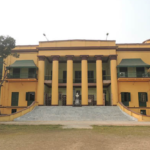Deep within the bustling heart of Uttarpara, West Bengal, lies a place steeped in history and shrouded in a touch of mystery – the Muktakeshi Kali Temple. This ancient temple, dedicated to the fierce yet benevolent Goddess Kali, has captivated devotees and history buffs alike for centuries. Today, we embark on a journey to unravel the secrets of the Muktakeshi Kali Temple, exploring its rich past, captivating legends, and its enduring significance in the cultural tapestry of Uttarpara.
More than 300 years ago, family members of Sabarna Roy Choudhury built the Muktakeshi Kali temple. Today the temple attracts hundreds of pilgrims from all over South Bengal. The pictursq temple is situated on western banks of river Hooghly, overlooking Vivekananda bridge. The famous Dakshineshwar Kali temple is situated just opposite it, across Hooghly river.
It is said that during her search for a suitable site, Rani Rasmoni selected this place for her temple. However, Ma Kali told her in her dream to build the temple on eastern side of river Hooghly as She was already residing on the temple of the Sabarna family.
A Temple Older Than Time: Unveiling the Origins
Pinpointing the exact origins of the Muktakeshi Kali Temple remains a captivating historical puzzle. While definitive records are scarce, local legends and architectural styles suggest the temple’s existence predates documented history. Some believe its construction dates back to the Pala Dynasty (750-1174 CE), while others whisper tales of its even older roots. The temple’s unique architectural style, featuring a curvilinear roof and ornately carved terracotta panels, hints at a bygone era of craftsmanship.
The Enigmatic Muktakeshi: Unveiling the Goddess
The name “Muktakeshi” itself sparks curiosity. Unlike the more common depictions of Kali with four arms and a fierce demeanor, the Muktakeshi idol is unique. The word “Muktakeshi” translates to “with open hair,” and this idol embodies this very essence. The Goddess Kali stands tall, adorned with a serene expression and her hair flowing freely, a stark contrast to the more ferocious portrayals. This unique depiction has fueled local legends and added to the temple’s mystique.
Legends and Folklore: Unveiling the Temple’s Soul
Several captivating legends weave through the history of the Muktakeshi Kali Temple. One popular tale narrates the story of a pious woman named Mukta, a devotee of Goddess Kali. Legend has it that Mukta dreamt of Kali, who instructed her to unearth an idol buried beneath a banyan tree. Following the divine vision, Mukta unearthed the idol, which bore the unique feature of open hair – thus christening the temple “Muktakeshi Kali Temple.”
Another legend speaks of the temple’s miraculous survival during a devastating earthquake. The story goes that while surrounding structures crumbled, the Muktakeshi Kali Temple remained miraculously untouched, solidifying the belief in the temple’s divine aura and the protective power of the Goddess.
A Beacon of Faith: A Sanctuary for Devotees
Regardless of its origins or captivating legends, the Muktakeshi Kali Temple has become a sanctuary for devotees for centuries. The temple pulsates with a vibrant spiritual energy, attracting worshippers from all walks of life. The daily rituals, the rhythmic chanting of hymns, and the aroma of incense create a mesmerizing atmosphere, allowing devotees to connect with the divine.
Beyond Religious Significance: A Cultural Treasure Trove
The Muktakeshi Kali Temple transcends its religious significance. The intricate terracotta artwork adorning the temple walls tells stories of Hindu mythology and bygone eras. These panels depict scenes from epics like the Ramayana and Mahabharata, offering a glimpse into ancient art forms and storytelling traditions. The temple is not just a place of worship but also a window into Uttarpara’s rich cultural heritage.
A Walk Through Time: Unveiling the Temple’s Architecture
Stepping into the Muktakeshi Kali Temple is like stepping back in time. The red brick structure, adorned with intricate carvings, exudes an old-world charm. The sanctum sanctorum, the innermost chamber housing the idol, is a tranquil space where devotees can offer prayers and find solace. The courtyard, often bustling with activity during festivals, provides a space for worshippers to connect and celebrate their faith.
Challenges and the Road Ahead: Preserving a Legacy
Like many historical structures, the Muktakeshi Kali Temple faces the challenge of preserving its heritage. Time and the elements take their toll, and ongoing conservation efforts are crucial in ensuring the temple’s survival for generations to come. Additionally, raising awareness about the temple’s unique history and cultural significance is essential.
A Call to Action: Be a Part of the Legacy
The Muktakeshi Kali Temple is not just a place of worship; it’s a living testament to Uttarpara’s rich past. We, as a community, can play a vital role in preserving its legacy. By spreading awareness, volunteering for conservation efforts, or simply visiting the temple and appreciating its beauty, we can all contribute to ensuring that this captivating landmark continues to enthrall and inspire generations to come.
So, the next time you find yourself in Uttarpara, take a moment to step away from the bustling streets and delve into the mystical aura of the Muktakeshi Kali Temple. Unveil its secrets, be captivated by its legends, and experience the enduring power of faith and




